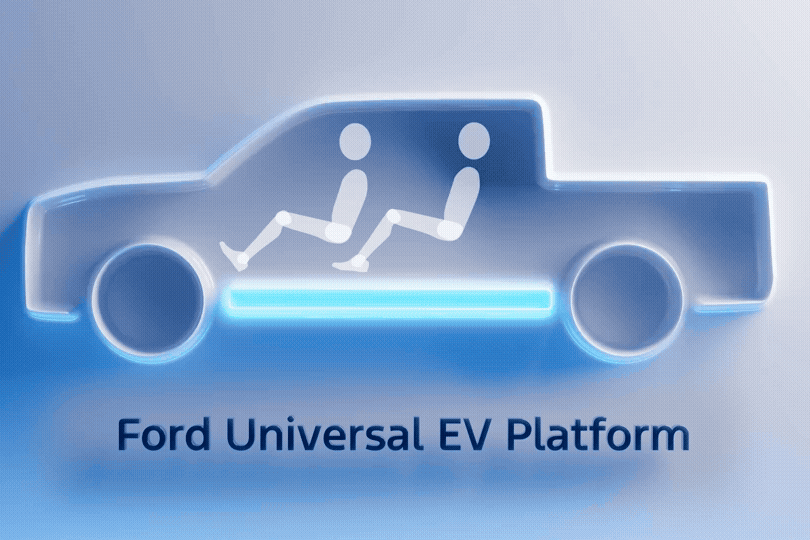Ford’s Three-Piece EV Manufacturing: A Bold Move or an Over-Engineered Lego Set?
Hello everyone. Gather ‘round, because Ford has decided to leap into the EV future with something so radical that it almost makes you suspect they’ve been sneaking furtive glances at Tesla’s homework – and then deciding to one-up them out of pure spite. Jim Farley, Ford’s top boss, isn’t just selling you a car anymore; he’s apparently trying to sell you on a near-religious manufacturing revelation. The “Ford Universal EV Production System” is here, and it’s less an assembly line and more an assembly tree. Yes, a tree. More branches, fewer excuses. Sounds nice, right? Let’s dig into whether this is the Second Coming of automotive engineering or just new paint on the same old jalopy.
The Gimmick – Sorry, “Innovation”
Ford’s pitch is simple: build the front, middle, and rear of an EV separately, then bolt them together at the end. This, we are told, is a revolutionary idea on par with inventing the wheel, or at least inventing the self-checkout machine that still needs one human attendant per two lanes because people can’t work the scanner. It’s supposedly 40% faster, needs 20% fewer parts, and has 30% fewer fasteners. Because nothing screams reliability like fewer bolts keeping your electric pickup from becoming three separate vehicles in the middle of a pothole-ridden commute.
The concept isn’t entirely fresh – Tesla has muttered about this “unboxed process” before – but Ford has actually done it. If that’s true, they’ve put Elon in the awkward position of explaining why the most he’s shown us so far is a PowerPoint slide and a sheepish grin.
Engineering Meets “Lego Duplo”
The modular design isn’t just for flexibility; it’s apparently for fun too. Ford describes their new platform as “Duplo-style.” Because nothing says cutting-edge automotive tech like comparing it to toddler building blocks. It’s scalable – from compact cars to three-row SUVs – and the centerpiece is a structural LFP battery forming the floor of the car. Seats mount directly on it. No frame, no fuss. I’m sure the insurance companies will have an absolute ball pricing collision repairs on that innovation.
The LFP battery is cheaper, lighter, and shorter (in wiring length by nearly a mile). You save money and material, but also introduce design headaches like preventing your car from folding in half during production or painting your future pickup when it exists as three dismembered pieces. Small issues, really – provided you have a literal army of engineers with Apollo 13 mission control energy.
The Game Plan
- Production at Ford’s Louisville plant, $2 billion investment.
- First product: midsize electric pickup in 2027.
- Target base price: $30,000 – faster than a Mustang EcoBoost, roomier than a Toyota RAV4.
- New 400-volt modular architecture.
On paper, this is an RPG-level min-maxed stat sheet: cost down, speed up, weight reduced, output diversified. In the hands of a decent raid party, you’d clear the dungeon and loot the epic gear in half the time. But in the real world, production plants are more “escort quest” than “boss rush” – too many points where the NPC gets stuck behind a doorway, and suddenly your whole efficiency run is toast.
The Talent Behind the Tour de Force
This wasn’t achieved by Ford’s usual bureaucracy – which, let’s be honest, moves with the urgency of an MMO server patch deployment in 2004. No, it was a skunkworks team led by Alan Clarke, poached from Tesla. He went from a one-man show to a world-class team in three years. That’s basically speedrunning corporate R&D, and unlike most modern speedruns, this wasn’t a glitch exploit – it’s raw execution and maybe just a sprinkle of “we’re tired of being embarrassed by China.”
Farley’s rhetoric is clear: you can’t beat BYD on scale or vertical integration, so you try to outgun them on cleverness. That’s the thesis here. Smaller batteries via powertrain wizardry, faster builds, leaner designs. It’s the manufacturing equivalent of swapping your sniper rifle for a silenced SMG and sprinting through the map before the heavy hitters even log in.
So… Genius or Gimmick?
The cynical doctor in me diagnoses this as a case of “Looks Promising Syndrome.” Early symptoms include slick press quotes, tantalizing specs, and the infectious smugness of being first to market with something your rival only teased. But as in medicine – and in game development – execution is everything. Show me the body count… or in this case, the production count. Will these EVs roll out on time and on budget, or will Ford discover that bolting three massive modules together at the end is low-key a nightmare?
It’s possible we’re looking at a turning point here, where Ford genuinely leapfrogs Tesla and fends off the Chinese onslaught using raw innovation rather than brute-force scale. On the other hand, this could become another entry in the Big Book of Overpromised Manufacturing Miracles, somewhere between “Apple Car” and “self-driving taxis that definitely won’t run you over.”
Conclusion
Ford’s new three-piece EV production method is bold, clever, and has all the right numbers in the right columns. But I’ll save the standing ovation for when those $30,000 pickups start hitting showrooms without Ford hemorrhaging cash or quality control. Until then, consider me cautiously impressed – like seeing a promising alpha build that still has “placeholder textures” written all over it.
And that, ladies and gentlemen, is entirely my opinion.






Article source: Ford’s Answer to China: A Completely New Way of Making Cars, https://www.wired.com/story/fords-answer-to-china-a-completely-new-way-of-making-cars/



